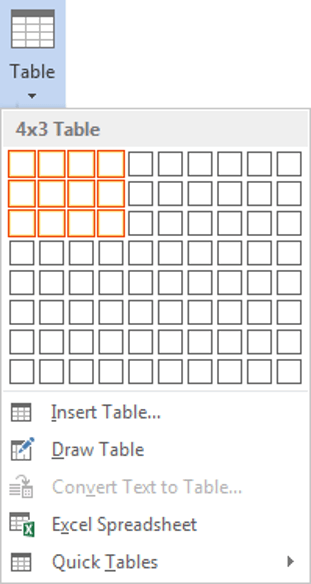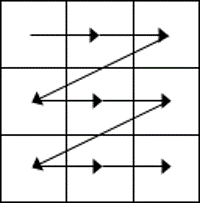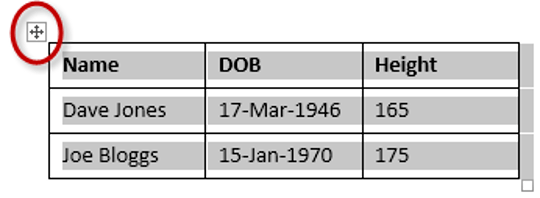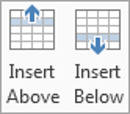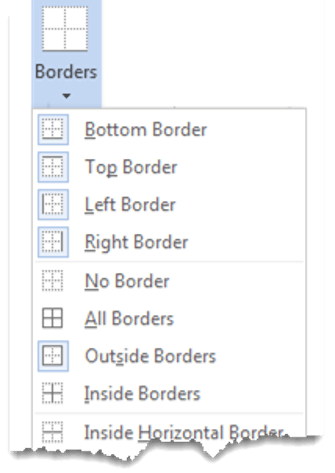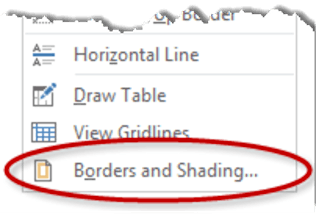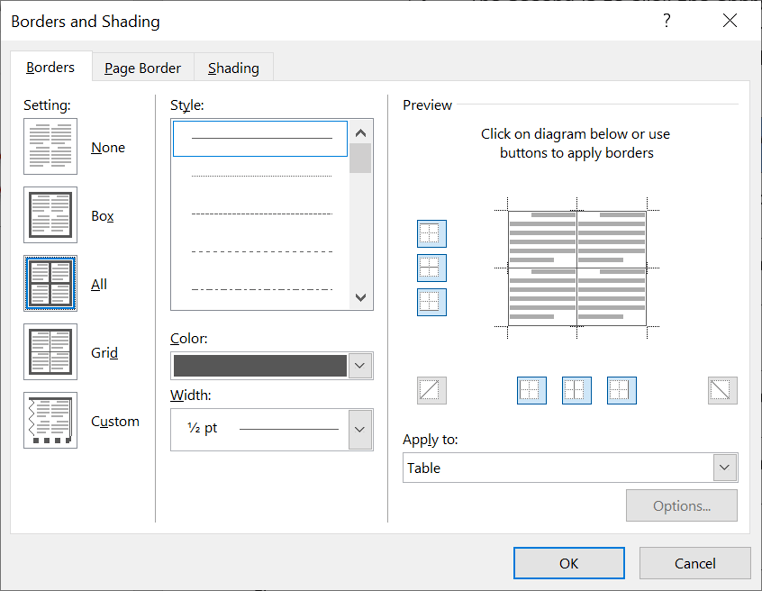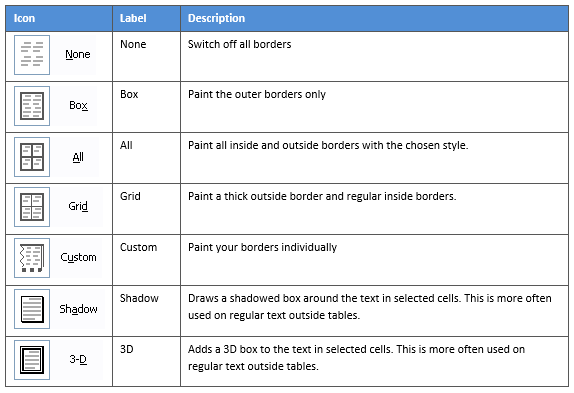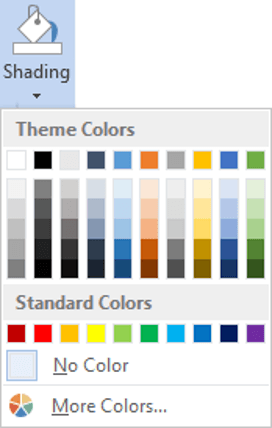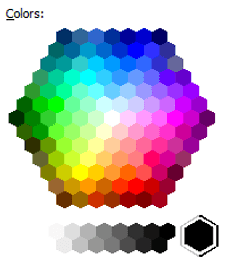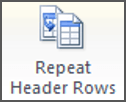Written by Allen Wyatt (last updated May 25, 2019)
This tip applies to Word 2007, 2010, 2013, 2016, 2019, and Word in Microsoft 365
Sometimes when Len copies and pastes a table from one document to another the table exceeds the width of the page, sometimes by a very large amount. He wonders if there is a good, easy way to resize the large table so that it fits within the margins of the document into which he pasted it.
There are a couple of approaches you can use to get your table back in control. The first (and perhaps easiest) is to simply click anywhere within any visible portion of the table. Word should display two new ribbon tabs: Design and Layout. Click on the Layout tab, click the AutoFit tool, and then choose AutoFit Window. Word makes sure that the table fits within the margins of the page.
Another way to accomplish the same task is to click the small square that appears at the upper-left corner of the table. (This small square has a four-headed arrow within it, and clicking it once selects the entire table.) Right-click within the table to display a Context menu. Choose AutoFit and then AutoFit Window.
Finally, another option is to right-click within the table to display a Context menu. Choose Table Properties and Word displays the Table Properties dialog box. (See Figure 1.)
Figure 1. The Table tab of the Table Properties dialog box.
On the Table tab of the dialog box, set the Preferred width to 100%. When you click OK, the table is snapped back into the page margins.
WordTips is your source for cost-effective Microsoft Word training.
(Microsoft Word is the most popular word processing software in the world.)
This tip (12585) applies to Microsoft Word 2007, 2010, 2013, 2016, 2019, and Word in Microsoft 365.
Author Bio
With more than 50 non-fiction books and numerous magazine articles to his credit, Allen Wyatt is an internationally recognized author. He is president of Sharon Parq Associates, a computer and publishing services company. Learn more about Allen…
MORE FROM ALLEN
Determining the Number of Visible Columns
When using a macro to process information in a worksheet, you may want that macro to figure out how many columns are …
Discover More
Setting a Transparent Color for an Image
Want to «see through» an image you place on a worksheet? You can do so by using the steps in this tip.
Discover More
Formatting a PivotTable
You can format PivotTables using either manual formatting or automatic formatting. You need to be careful, however, as …
Discover More
More WordTips (ribbon)
Table Borders Won’t Print
Print a table and you may be surprised if it has no borders. That could be because you actually have the borders turned …
Discover More
Filling Table Cells with Sequential Numbers
Excel makes it very easy to add sequential numbers to a range of cells. Not so in Word’s tables, where adding such …
Discover More
Filling Table Cells with a Macro
Want to stuff a value into each cell of a table? You can either type the value over and over and over again, or you can …
Discover More
Word for Microsoft 365 for Mac PowerPoint for Microsoft 365 for Mac Word 2021 for Mac PowerPoint 2021 for Mac Word 2019 for Mac PowerPoint 2019 for Mac Word 2016 for Mac PowerPoint 2016 for Mac Word for Mac 2011 PowerPoint for Mac 2011 More…Less
You can resize an entire table to improve readability or to improve the visual effect of your document. You can also resize one or more rows, columns, or individual cells in a table.
Resize a table
-
Rest the pointer on the lower-right corner of the table until
appears, and then drag the table boundary until the table is the size that you want.
Resize rows, columns, or cells
-
Select the table.
The contextual tabs, Table Design and Layout, appear in the ribbon.
-
On the Layout tab, you can specify the custom height and width.
To resize specific rows or column, click on a cell and then adjust the row/column.
To make multiple rows or columns the same size, select the columns or rows and click Distribute Rows or Distribute Columns.
Which Office program are you using?
-
Word
-
PowerPoint
Word
You can resize a whole table to improve readability or to improve the visual effect of your document. You can also resize one or more rows, columns, or individual cells in a table.
Do any of the following:
Resize a table
-
On the View menu, click Print Layout or Publishing Layout.
-
Click the table.
-
Rest the pointer on the lower-right corner of the table until
appears, and then drag the table boundary until the table is the size that you want.
Change the row height in a table
-
On the View menu, click Print Layout or Publishing Layout.
-
Rest the pointer on the row boundary that you want to move until
appears, and then drag the boundary until the row is the height that you want.
If you have text in a table cell, the row must be the same height or taller than the text.
Tip: To display row height measurements on the vertical ruler, click a cell, and then hold down OPTION as you drag the boundary.
Change the column width in a table
-
On the View menu, click Print Layout or Publishing Layout.
-
Rest the pointer on the column boundary that you want to move until
appears, and then drag the boundary until the column is as wide as you want.
If you have text in a table cell, the column must be as wide as or wider than the text.
Tip: To display column width measurements on the horizontal ruler, click a cell, and then hold down OPTION as you drag the boundary.
Make multiple rows or columns the same size
-
Select the columns or rows that you want to make the same size, and then click the Table Layout tab.
-
Under Cell Size, click Distribute Rows or Distribute Columns.
Change the space between cells in a table
-
Click the table, and then click the Table Layout tab.
-
Under Settings, click Properties.
-
Click the Table tab, and then click Options.
-
Under Default cell spacing, select the Allow spacing between cells check box, and then enter the measurement that you want.
PowerPoint
You can resize a whole table to improve readability or to improve the visual effect of your document. You can also resize one or more rows, columns, or individual cells in a table.
Do any of the following:
Resize a table
-
Click the table.
-
Rest the pointer on any corner of the table until
appears, and then drag the table boundary until the table is the size that you want.
Change the row height in a table
-
Rest the pointer on the row boundary that you want to move until
appears, and then drag the boundary until the row is the height that you want.
If you have text in a table cell, the row must be the same height or taller than the text.
Change the column width in a table
-
Rest the pointer on the column boundary that you want to move until
appears, and then drag the boundary until the column is as wide as you want.
If you have text in a table cell, the column must be as wide as or wider than the text.
Change the row or column to fit the text
-
Rest the pointer on the column boundary until
appears or the row boundary until
appears, and then double-click it.
Make multiple rows or columns the same size
-
Select the columns or rows that you want to make the same size, and then click the Table Layout tab.
-
Under Cells, click Distribute Rows or Distribute Columns.
See also
Add or delete rows or columns in a table
Merge or split cells in a table in PowerPoint
Add a border to a table
Insert a table in Word
Need more help?
Want more options?
Explore subscription benefits, browse training courses, learn how to secure your device, and more.
Communities help you ask and answer questions, give feedback, and hear from experts with rich knowledge.
I’ve tried many times to insert an Excel table with 17 columns in a Word 2010 document without changing the layout.
Please explain the process to insert a big Excel table in a Word document.
Ola Ström
4641 gold badge4 silver badges14 bronze badges
asked Mar 3, 2016 at 4:23
2
Click on View Tab and choose Draft view. Now you can paste table of any width without disturbing the layout. You still need to format the table in order to print though.
answered Mar 3, 2016 at 7:10
Tables in Word are useful in so many situations. In this post you’ll discover how to create tables, then manipulate and design them in the quickest and easiest way to provide that visual punch.
Clickable Table of Contents
Enhance your Word tables with these advanced features
1. What are tables in Word good for?
Tables are useful for 2 distinct reasons.
- To show an actual table of data, or
- To organise and postion text, images and other elements on the page.
Many years ago, typewriters ruled the world. And a feature of a good typewriter was the tab stop, which was a device that essentially let you control indentation.
Over the years many people have continued to use tabs to indent text, because of its convenience, but they are hard work to set up properly.
Tables provide a much easier way to organise content on a page.
1. Select the Insert tab.
2. Click the Tables icon in the Tables group.
3. Move your mouse pointer into the table grid until the required number of rows and columns are highlighted orange, then left-click.
An empty table is inserted into the document.
Two new tabs, Design and Layout are also added to the ribbon area, under the banner of Table Tools.
3. MOVING AROUND A Word TABLE
- While the table is empty, you can use the cursor keys to move around the cells. However, when the cells contain information, using the cursor keys will move through the cell content first before moving to the next cell
- You can left-click in any cell to position the cursor.
- Press Tab to move to the next cell. The cursor will move across and then down the table.
- Press Shift + Tab to move to the previous cell.
NB. Using Tab is better than using the cursors as it will move to the next/previous cell regardless of whether there is information in the cells.
NB2. If you press Tab while you are in the last cell, a new row will be added to the bottom of your table
4. SELECTING A CELL, ROW, COLUMN OR THE ENTIRE TABLE
To select a cell:
1. Position the mouse pointer inside the cell on the bottom-left corner of the cell.
The pointer will change shape to a solid black arrow that points up and right.
2. Left-click.
To select a row of a table:
1. Position the mouse pointer in the left margin in line with the row you want to select.
The mouse pointer will change to a white arrow that points up and right.
2. Left-click.
To select a column
1. Position the mouse pointer so that it rests on the top border of the table, above the column you want to select.
The mouse pointer will change to a solid black arrow pointing down.
2. Left-click.
To select the entire table:
1. Position your mouse pointer over the 4-headed arrow icon situated at the top-left of the table.
2. Left-click.
5. INSERTING AN EXTRA ROW OR COLUMN
To insert an extra row:
1. Position the cursor in a cell.
2. Select the Layout tab, under the Table Tools banner.
3. Click Insert Above or Insert Below in the Rows and Columns group
Here is a quick way to insert new rows:
1. Position the cursor to the left of the table, but in close proximity.
2. A plus symbol will appear above or below the mouse pointer indicating where the new row will be added.
3. Nudge the mouse pointer up or down to move the plus sign above or below.
4. Left-click to insert the new row,
To insert an extra column:
1. Position the cursor in a cell.
2. Select the Layout tab, under the Table Tools banner.
3. Click Insert Left or Insert Right in the Rows and Columns group
Here is a quick way to insert a new column:
1. Position the cursor above a column, but in close proximity to the table.
2. A plus symbol will appear to the left or right of the mouse pointer indicating where the new column will be added.
3. Nudge the mouse pointer left or right to move the plus sign to the left or the right of the column.
4. Left-click to insert the new column,
6. DELETING A ROW OR COLUMN
To delete the current row or column:
1. Position the cursor in any cell of the row you want to delete.
2. Select the Layout tab, under the Table Tools banner.
3. Click the Delete icon in the Rows and Columns group.
4. Choose Delete Row or Delete Column from the drop-down menu.
7. Quickly fORMATTING tables in Word
Word provides you with a number of pre-set table designs. This means that it formats the headings and the data, applies a variety of borders and colours the cells in a way that makes it look like a professionally produced table. As a beginner this simple technique will give you a good-looking table.
1. Position the cursor in any cell in the table.
2. Select the Design tab under the Table Tools banner.
The Table Styles group lists a number of table designs. To get the full list, click the More button beneath the table styles scroll bar
The default table style is Table Grid in the Plain Tables category which adds simple gridlines but no shading to your table.
Live Preview allows you to hover over a design and see it applied to your table. If you like what you see, click to select the table design.
In the Table Style Options group of the Design tab, tick the components that you have in your table. For example, if your table has column headings, tick Header Row. In doing this, the various parts of your table are formatted accordingly
Header Row
This will emphasise the header row by making the text bold or applying a different cell colour (depending on the table style selected.
Total Row
This will emphasise the bottom table row by making the text bold or applying a different cell colour (depending on the table style selected.
First Column
This will emphasise the first column (for labels etc.) by making the text bold or applying a different cell colour (depending on the table style selected.
Last Column
This will emphasise the last column (for row totals etc.) by making the text bold or applying a different cell colour (depending on the table style selected.
Banded Rows
This will make odd rows one colour and even rows a different colour. This helps readability.
Banded Columns
This will make odd columns one colour and even columns a different colour. This helps readability.
8. SETTING THE BORDERS AND SHADING
The Table Styles Gallery allows you to completely format a table with one click. Whereas you used to need some nous, anybody can now create a professional looking design.
However, you will often still need to apply your own border and shading, and manually change a table design. With a little effort can add a lot of flavour to your page and dramatically enhance the overall appearance of the document.
To set the borders for tables in Word:
1. Select the portion of the table that you wish to set the borders for. This may be the entire table, a row or rows, a column or columns or a selection of cells.
2. Select the Design tab under the Table Tools banner.
3. Select the Borders icon. A drop-down list appears. This list shows every combination of border that can be turned on or off. The icons with a shaded background are currently switched on. The rest are switched off.
4. Click any icon to switch the border on or off. The border style that is applied is the default style (½ pt solid black line ) or the last style that was used.
5. To apply customised borders, with different colours, styles and widths, click the Borders & Shading option at the bottom of the list to display the Borders and Shading dialog box.
Your selection will always have an outer border, and if you selected more than one cell, you will have some inside borders as well. The easiest way to use the dialog box is to start on the bottom-middle and work your way up and right.
1. Select the colour and width (thickness) that you would like for your border.
2. Choose a style (e.g. dotted, dashed, double, solid etc.)
3. Paint your borders. There are two ways to do this.
- The first way is to click directly on a border in the Preview itself.
- The second way is to click the appropriate icon around the edge of the Preview section that represents each border. Depending on which cells you selected in your table, some of these icons may not be available.
On the left-hand side of the dialog box, there are some pre-defined border combinations which you can use to save yourself some time. Depending on your selection of cells, the pre-defined options may differ. Here’s a run-down:
To shade the cells of tables in Word:
1. Select the portion of the table that you wish to shade. This may be the entire table, a row or rows, a column or columns or a selection of cells.
2. Select the Design tab under the Table Tools banner.
3. Click the Shading icon.
The colours that you see displayed match the current them of the document. Themes were discussed earlier in the course.
4. Click a colour in the palette.
While you can pick any colour, it is recommended to stick with the light colour shades, otherwise your tables will appear very loud and ugly, like they’re shouting in your face. Subtle is the order of the day. The exception to this is column headings or other cells that you wish to differentiate. Under these circumstances, you can use a dark colour, but use a light font with it.
If you cannot find the exact colour you need,
- Click the More Colours link underneath the palette. This displays a larger, more accurate colour palette.
- And if that’s not enough, click the Custom tab and you’ll get a really fine selection of colours (you can even enter your own RGB settings if you know them)
9. REPEATING table HEADINGS ON EVERY PAGE WHEN PRINTING
When you have large tables that occupy two or more pages, many people insert manual page breaks, then copy and paste their table header rows at the top of each page.
When rows are added or removed from tables in Word, the table headers end up half way down the page.
There is a simple tool that will eliminate this problem
1. Ensure that the table is a single table, with no manual page breaks in the middle, and one header at the top. The table header may occupy more than one row, it doesn’t affect the way this feature works.
2. Position the cursor somewhere in the top row of the table.
3. Select the Layout tab under the Table Tools banner.
4. Click the Repeat Header Rows icon ion the Data group.
Now, it doesn’t matter how many rows tables in Word contain, if the table ever spills across into another page, the header row (which normally displays the column headings) will always appear at the top of the table.
10. All the key points again
- Tables in Word serve 2 distinct purpose: to display a table of data and to organise and position items on the page
- To create table, select 2 tabs — Design and Layout under the Table Tools banner.
- There are 2 tabs — Design and Layout under the Table Tools banner.
- You can press the TAB key to move direct to the next cell and SHIFT and TAB together to move backwards through a table.
- The four elements of a table are cells, rows, columns and the whole table. Each can be selected.
- Rows can be inserted by selecting the Layout tab under Table Tools, then clicking the Insert Above or Insert Below icons. Alternatively, hover to the left of a row and click the plus symbol that appears above or below the mouse pointer.
- Columns can be inserted by selecting the Layout tab under Table Tools, then clicking the Insert
Left or Insert Right icons. Alternatively, hover above a table column and click the plus symbol that appears to the left or right of the mouse pointer. - Columns and rows and be removed from the table, by positioning the cursor in the row or column to be removed, then clicking the Delete icon on the Layout tab of Table Tools and choosing Delete
Row or Delete Column. - Tables can be formatted using the Table Style gallery or by manually setting the shading and borders manually. Both sets of tools are found on the Design ribbon of the Table Tools.
- When using the Microsoft Table Styles, you can control the behaviour of the formatting by setting the Table Style options – 6 tick boxes that define the structure of your table.
- For long tables that spill across onto subsequent pages, the top row, which normally contains the column headings can be set to repeat automatically. So there is no excuse for cutting and pasting headings midway through your table or taping pages together to make sense of the table!
I hope you found plenty of value in this post. I’d love to hear your biggest takeaway in the comments below together with any questions you may have.
Have a fantastic day.
About the author
Jason Morrell
Jason loves to simplify the hard stuff, cut the fluff and share what actually works. Things that make a difference. Things that slash hours from your daily work tasks. He runs a software training business in Queensland, Australia, lives on the Gold Coast with his wife and 4 kids and often talks about himself in the third person!
SHARE
A lot of documents Word contain tables. If you have a small table, you may want to keep it on
one page even if Word tries to split it between pages.
To keep a table on one page, do the following:
1. Select the table:
- You can select all rows or columns of the table one by one
- Move the mouse over the table until you see the table selection icons in the upper-left
corner of the table and then click it:

Note: You can also click on the table selection icon in the bottom-right corner
for the same effect.
2. On the Home tab, in the Paragraph
group, click the dialog box launcher:

3. In the Paragraph dialog box, on the
Line and Page Breaks tab, select the Keep with next checkbox:
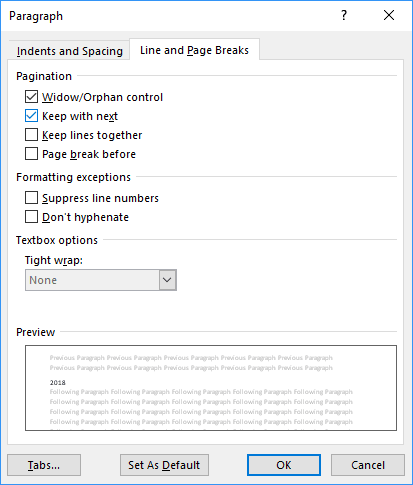
If you use the option Keep with next for entire table, it won’t be split to the different
pages:
- Before changes:
- After changes:
Notes:
- You can keep the text before the table with it, just do the same for the paragraph of the
text that you want to keep with the table.See
How to keep lines and paragraphs together in Word document. - If you have a big table that it can’t be displayed on one page, Word moves it on the next
page even if only one symbol leaves on the page and splits it anyway:
See also this tip in French:
Comment conserver un tableau dans une page d’un document Word.
Please, disable AdBlock and reload the page to continue
Today, 30% of our visitors use Ad-Block to block ads.We understand your pain with ads, but without ads, we won’t be able to provide you with free content soon. If you need our content for work or study, please support our efforts and disable AdBlock for our site. As you will see, we have a lot of helpful information to share.

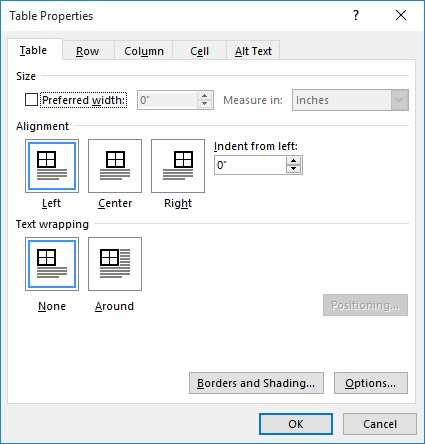
 appears, and then drag the table boundary until the table is the size that you want.
appears, and then drag the table boundary until the table is the size that you want. 

 appears, and then drag the boundary until the row is the height that you want.
appears, and then drag the boundary until the row is the height that you want.  appears, and then drag the boundary until the column is as wide as you want.
appears, and then drag the boundary until the column is as wide as you want. 


